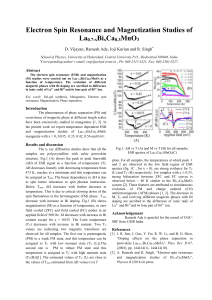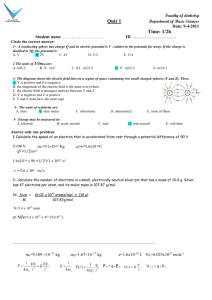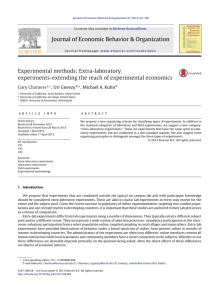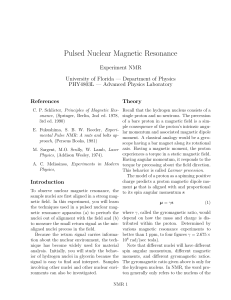Final Revised Suppliment of the Manuscript LSMO
advertisement
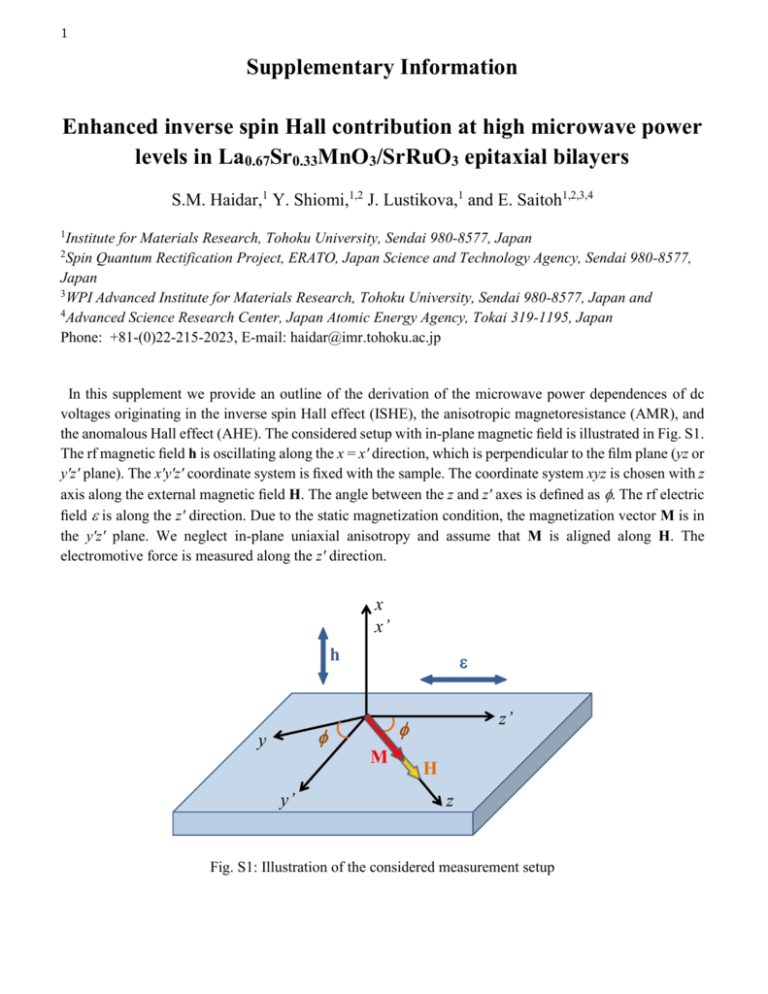
1 Supplementary Information Enhanced inverse spin Hall contribution at high microwave power levels in La0.67Sr0.33MnO3/SrRuO3 epitaxial bilayers S.M. Haidar,1 Y. Shiomi,1,2 J. Lustikova,1 and E. Saitoh1,2,3,4 1 Institute for Materials Research, Tohoku University, Sendai 980-8577, Japan Spin Quantum Rectification Project, ERATO, Japan Science and Technology Agency, Sendai 980-8577, Japan 3 WPI Advanced Institute for Materials Research, Tohoku University, Sendai 980-8577, Japan and 4 Advanced Science Research Center, Japan Atomic Energy Agency, Tokai 319-1195, Japan Phone: +81-(0)22-215-2023, E-mail: haidar@imr.tohoku.ac.jp 2 In this supplement we provide an outline of the derivation of the microwave power dependences of dc voltages originating in the inverse spin Hall effect (ISHE), the anisotropic magnetoresistance (AMR), and the anomalous Hall effect (AHE). The considered setup with in-plane magnetic field is illustrated in Fig. S1. The rf magnetic field h is oscillating along the x = x′ direction, which is perpendicular to the film plane (yz or y′z′ plane). The x′y′z′ coordinate system is fixed with the sample. The coordinate system xyz is chosen with z axis along the external magnetic field H. The angle between the z and z′ axes is defined as . The rf electric field is along the z′ direction. Due to the static magnetization condition, the magnetization vector M is in the y′z′ plane. We neglect in-plane uniaxial anisotropy and assume that M is aligned along H. The electromotive force is measured along the z′ direction. x x’ h y M y’ z’ H z Fig. S1: Illustration of the considered measurement setup 2 The magnetization dynamics in the ferromagnetic layer is obtained by analytically solving the Landau-Lifshitz-Gilbert equation, 𝑑𝐌(𝑡) 𝛼 𝑑𝐌(𝑡) = −𝛾𝐌(𝑡) × 𝜇0 𝐇eff + 𝐌(𝑡) × 𝑑𝑡 𝑀 𝑑𝑡 (S1) where is the gyromagnetic ratio and is the damping parameter. Here, the time-dependent magnetization vector M (t) is a sum of the static magnetization vector M = (0, 0, MS) and the time dependent oscillatory component m (t) = (mxeit, myeit, 0). The effective field Heff is a sum of the external field H = (0, 0, H), the rf field h = (heit, 0, 0) and the rf demagnetizing field Hm = (-mxeit, 0, 0) induced by the dynamic magnetization. Neglecting h, m terms of second order, the solution of Eq. (S1) becomes 𝐦= 1 𝛾𝑀S ℎ[𝛾(𝜇0 𝐻 + 𝜇0 𝑀S ) + 𝑖𝛼𝜔] 𝑖𝜔𝑡 ( )𝑒 −𝑖𝛾𝜔𝑀S ℎ Ξ (S2) where Ξ = 𝛾 2 𝜇0 𝐻(𝜇0 𝐻 + 𝜇0 𝑀S ) − (1 + 𝛼 2 )𝜔2 + 𝑖𝛼𝜔𝛾(2𝜇0 𝐻 + 𝜇0 𝑀S ) (S3) For convenience, the real (Re) and imaginary (Im) parts of the dynamic magnetization in Eq. (S2) are defined as m = (Re(mx) + iIm(mx), Re(my) + iIm(my))eit.Analysis of the magnetic field spectra shows that Im(mx), Re(my) have a Lorentzian shape, while Re(mx), Im(my) is a have a dispersive shape.40 The spin current injected into the paramagnet at the FMR of the ferromagnet is proportional to the time-averaged magnetization precession cone12 jS ∝ 𝑔𝑟↑↓ 1 ̅̅̅̅̅̅̅̅̅̅̅̅̅̅̅̅̅̅̅̅̅̅̅̅ 𝑑𝐌(𝑡) ] 2 Re [𝐌(𝑡) × 𝑑𝑡 𝑀S (S4) Where 𝑔𝑟↑↓ is the spin mixing conductance. The only non-zero spatial component of the spin current is along the z direction, and is proportional to [Im(mx)Re(my) - Re(mx)Im(my)]. This has a Lorentzian spectral shape. The electromotive force due to ISHE, which is proportional to the vector product of the injected spin current and the spin polarization direction, 𝐄ISHE ∝ 𝐣S × 𝛔, along the z′ direction can be then expressed as12 𝑉ISHE ∝ 𝜔 2 𝑔𝑟↑↓ 𝛾 2 ℎ2 ℏ [𝜇0 𝑀S + √(𝜇0 𝑀S )2 + 4 ( 𝛾 ) ] 8𝜋𝛼 2 [(𝜇 𝜔 2 2 0 𝑀S ) + 4 ( 𝛾 ) ] cos 𝜙 (S5) Using 𝑃 ∝ ℎ2 , considering the dependence of the mixing conductance on the sample linewidth and the magnetization,12 𝑔𝑟↑↓ ∝ 𝑀S (𝑊F/N − 𝑊F ), and assuming that the line width W is proportional to the damping constant , we obtain the following expression for ISHE 3 𝑉ISHE ∝ 𝜔 2 𝑃𝜇0 𝑀S [𝜇0 𝑀S + √(𝜇0 𝑀S )2 + 4 ( 𝛾 ) ] 𝛼 [(𝜇0 𝑀S )2 𝜔 2 + 4 (𝛾) ] (S6) The rf electric field in the xyz coordinates is = (0, cosM , - sinM)ei(t where is a general phase shift between the rf magnetic field and rf electric field. The spin rectification voltage due to AMR is 13, 41 Δ𝜌 ̅̅̅̅̅̅̅̅̅̅̅̅̅̅̅̅̅ 𝐄AMR ∝ ( 2 ) Re[(𝐌 ∙ 𝛆)𝐌] 𝜌𝑀S (S7) Where ∆/ is the anisotropic magnetoresistance coefficient. Using the results of Eq.(S1), the Lorentzian component of the AMR voltage measured along the z′ direction is proportional to ′ 𝑦 𝑧 𝑉AMR = 𝑉AMR sin 𝜙 Δ𝜌 ∝ ( 2 ) 𝑀S 𝜀 cos 𝜙 sin 𝜙 Re(𝑚𝑦 ) cos 𝛷 𝜌𝑀S (S8) At ferromagnetic resonance, Re(𝑚𝑦 ) = −𝜇0 𝑀S ℎ 𝜔 2 𝛼 √(𝜇0 𝑀S )2 + 4 ( 𝛾 ) (S9) Using 𝑃 ∝ 𝜀ℎ, we find that the expression for AMR including all power and/or temperature dependent parameters is ∆𝜌 𝑉AMR ∝ ( ) × 𝜌 𝑃 𝜔 2 𝛼 √(𝜇0 𝑀S )2 + 4 ( 𝛾 ) (S10) Similarly, the dc electromotive force due to the spin rectification by AHE is13, 41 ̅̅̅̅̅̅̅̅̅̅̅̅̅̅ 𝐄AMR ∝ 𝑅S 𝜎Re(𝛆 × 𝐌) (S11) where RS is the anomalous Hall coefficient and the electric conductivity. The contribution along the z′ direction becomes zero. If the direction of the electrodes is not perfectly aligned along the z′ direction, a contribution from the y′ direction can be detected, where the Lorentzian component is proportional to 𝑦′ 𝑉AHE ∝ 𝜀Im(𝑚𝑥 ) sin Φ (S12) 4 At ferromagnetic resonance, Im(𝑚𝑥 ) = −𝜇0 𝑀S ℎ 𝜔 × 2𝛼 ( 𝛾 ) 𝜔 2 𝜇0 𝑀S + √(𝜇0 𝑀S )2 + 4 ( 𝛾 ) 𝜔 2 √(𝜇0 𝑀S )2 + 4 ( ) 𝛾 (S13) Including all parameters that may depend on P or temperature, we obtain 𝑉AHE ∝ 𝑅S 𝜎𝑃 × 𝜇0 𝑀S 𝜔 × 2𝛼 ( ) 𝛾 𝜔 2 𝜇0 𝑀S + √(𝜇0 𝑀S )2 + 4 ( 𝛾 ) √(𝜇0 𝑀S )2 𝜔 2 + 4( ) 𝛾 (S14) Supplementary References 40 J. Lustikova, Y. Shiomi, and E. Saitoh, under review (2015). J.-P. Jan, Galvanomagnetic and thermomagnetic effects in metals, Solid State Phys. 5, 1-96 (1957). 41



